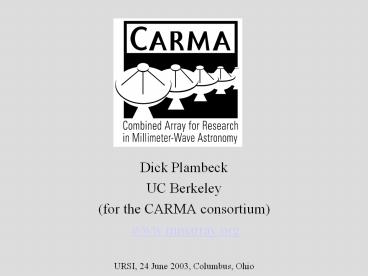CARMA - PowerPoint PPT Presentation
Title:
CARMA
Description:
3 different antenna diameters - a heterogeneous array. exploit new algorithms for ... bandwidth, 1 polarization at first light. continuum sensitivity: 2-3 ... – PowerPoint PPT presentation
Number of Views:115
Avg rating:3.0/5.0
Title: CARMA
1
CARMA
- Dick Plambeck
- UC Berkeley
- (for the CARMA consortium)
- www.mmarray.org
- URSI, 24 June 2003, Columbus, Ohio
2
Berkeley-Illinois-Maryland Assn. array 10 6.1-m
diameter antennas
Caltech array 6 10.4-m
antennas
UChicago SZA 8 3.5-m antennas
3
people
project manager Tony Beasley
- OVRO
- D. Woody
- S. Scott
- J. Lamb
- D. Hawkins
- J. Carpenter
- A. Sargent
- G. Blake
- N. Scoville
- Berkeley
- D. Plambeck
- M. Wright
- A. Bolatto
- C. Kraybill
- M. Fleming
- L. Blitz
- W.J. Welch
- Maryland
- M. Pound
- P. Teuben
- K. Rauch
- S. Vogel
- L. Mundy
- A. Harris
- Illinois
- R. Plante
- D. Mehringer
- L. Snyder
- R. Crutcher
- L. Looney
programmers, engineers, technicians, postdocs,
graduate students
4
antennas
CARMA CARMA SZA
antennas 15 23
baselines 105 253
collecting area 773 m2 850 m2
- 3 different antenna diameters - a heterogeneous
array - exploit new algorithms for mosaicing, high
fidelity imaging - sensitive to wide range of spatial frequencies
image large objects
5
M33
6
BIMA mosaic of M33
- CO 1-0 115 GHz
- 759 pointing centers
7
BIMA mosaic of M33(Engargiola et al. 2003)
- 148 GMCs detected
- overlie HI filaments (HI image Deul van der
Hulst 1987)
8
receivers
freq (GHz) OVRO BIMA SZA
210-270 SIS SIS
85-116 SIS SIS (70-116) MMIC
29-37 HEMT HEMT
22 MMIC
- for the 1mm and 3mm bands
- 4 GHz bandwidth, 1 polarization at first light
- continuum sensitivity 2-3 mJy/beam, in 1 minute
- 230 GHz brightness sensitivity 1 K for 1 km/sec
channel, 1'' beam, in 1 hour
9
site selection and acquisition
- requirements
- within 60 minute drive of existing OVRO
infrastructure - elevation 7000-9000 ft for good atmospheric
transmission but low snow load - 400-m diameter flat area, baselines to 2 km
- avoid environmental battles
all such sites are in Inyo National Forest,
require Environmental Impact Report
10
environmental studies done for 2 sites
Cedar Flat
11
Juniper Flat 7900
12
Cedar Flat 7300
13
Cedar Flat 20 min drive to OVRO on paved road,
maintained (and plowed) by Caltrans
simulated antenna
Highway 168
14
225 GHz
? Percentiles 25 lt 0.12 50 lt 0.16 75 lt 0.28
15
BIMA antenna move
- keep dish and feed legs in one piece
- move 9 antennas in 8 weeks
16
OVRO antennas will be dismantled to pass through
the narrows
17
array configurations
- 5 antenna configurations, approx 55 pads
- 2 km max baseline
18
Cedar FlatE-array(most compact)synth beam
4.5" at 230 GHz
array center
19
E-array
- BIMA antennas within collision range
- SZA provides even shorter spacings
- combine with single dish measurements from 10.4-m
antennas to recover all spatial frequencies
20
A-array 0.13" synth beam
21
u,v coverage for declination 30 4-hr
observing track
22
A-array synthesized beam, declination 30 0.26
0.14" FWHM
5 contours
23
BIMA A-array detection of a stellar flare in
Orion (
86 GHz, synthesized beam 0.9 0.5" )
20 Jan 2003 4 UT
20 Jan 2003 8 UT
30 mJy
150 mJy
BN
IRc2
24
antenna transporter
- use common transporter for 6-m and 10-m antennas
- avoid custom vehicle
- 50 of weight on tow vehicle for traction
25
transporter tow vehicle 6-wheel drive military
truck (Oshkosh MTVR)
26
(No Transcript)
27
(No Transcript)
28
fiberoptics
- all communication with antennas via 8 singlemode
optical fibers - use standard SMF 28 fiber - length change with
temperature is 1 part in 105 - use BIMA round trip phase measuring system to
monitor fiber lengths
29
diurnal changes in fiber length (BIMA data from
July 2002)
Sun hits fibers
fiber lengths
- 135 of fiber at outdoor air temp (?
200 nsec) - ?? 2 psec/C
- ?? 180/C at 230 GHz
outdoor air temp
30
BIMA round trip phase measurement
advantage no electronics at the antenna, just a
fiber coupler disadvantage lengths of fibers 1
and 2 must track with temperature and flexure
(requires loose tube fiber)
31
raw phases on 3c454.3 through sunrise
32
phases on 3c454.3 through sunrise after correction
33
- Caltech COBRA correlator
- based on FPGAs, not custom correlator chips
- 4 GHz bandwidth
- 256 channels, 20 MHz resolution
- 15 baselines
34
(No Transcript)
35
CARMA first light correlator
- uses COBRA hardware design
- 15 telescopes, 105 baselines
- 8 independent sections
- may be positioned anywhere in 4 GHz IF band
- choose 2, 8, 31, 62, 125, 250, or 500 MHz
bandwidth - velocity resolution 0.04 to 40 km s-1/ channel at
1.3 mm
separate SZA correlator
8 antennas, 28 baselines, 8
GHz bandwidth
36
COBRA each board handles 5 baselines, 500
MHz/baseline, 32 chans/baselineCARMA reprogram
FPGAs to handle 10 baselines, add spectral
line capability
37
timeline
Jan 2003 draft environmental document submitted
Mar 2003 Forest Service decision Cedar Flat
Jun 2003 end of public comment period
Aug 2003 Forest Service record of decision
Oct 2003 appeals period ends
early 2004 SZA operational at high site
mid 2004 move OVRO and BIMA antennas to high site
2005 begin operation
38
BIMA summer school
39
Alberto Bolatto testing prototype WVR in Berkeley
40
Leslie Looney pulling underground fiber for long
baselines
John Carlstrom repairing the Air Products
refrigerator on receiver 3
41
7th graders at Hat Creek































